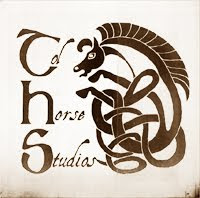Leg work, and an exercise
I managed to come down with a cold. In the middle of June. I don't know, either. Anyway. This led to a very important discovery: do not, no matter what, do a no-stirrup day and then get a cold. Achy body + tortured muscles + general ick feeling = Miserable.
Of course, I didn't know I was going to get a cold the night I did the no stirrup work, but whatever. It's still a valid point. Sadly, that ride didn't go too well. Toler decided that he could be a dork and misbehave.
He knew I didn't have stirrups, so there would only be so much I could do, so he was a complete brat. I mostly tried to do rail work, sitting trot work, and at the end--mostly because I was angry at him and didn't want him to think he could get away with things totally off the hook--we went through two dressage tests, one of them twice.
By the time we got to the second dressage test we were both so angry with each other, we reached the point of passive-aggressive obedience. "You want me to trot? Fine. I'll have the bounciest, most supple trot I possibly can. Oh, I'm not moving forward enough for you? Look, now I'm a Standardbred in the middle of a race. How is that? Hmm?"
He got a day off because I was too sick to ride, and the next day (yesterday) I didn't take any chances. Stirrups were back on the saddle, and the curb rein was back on the curb. And he was perfect. He was round and supple, light on the bit, and moving forward well into my aids. I was riding between two lessons, so I mostly did rail work, some bending, and then went over the exercise that had been laid out: Put two trot poles on each diagonal (raise them off the ground if the horse is comfortable/efficient with trot poles). Trot over the poles (yellow crayon) and canter around the corners and into the approach (blue crayon), so that you're transitioning to the trot just before the poles. At first, it will probably be a stride or two before the poles, as the horse needs to have a nice, consistant trot by the time they get to the poles. But as you progress in the exercise, the horse will get the hang of it and be able to transition right in front of the pole into a steady, impulsive trot. After the pole, cue the canter again.
Put two trot poles on each diagonal (raise them off the ground if the horse is comfortable/efficient with trot poles). Trot over the poles (yellow crayon) and canter around the corners and into the approach (blue crayon), so that you're transitioning to the trot just before the poles. At first, it will probably be a stride or two before the poles, as the horse needs to have a nice, consistant trot by the time they get to the poles. But as you progress in the exercise, the horse will get the hang of it and be able to transition right in front of the pole into a steady, impulsive trot. After the pole, cue the canter again.
This exercise is perfect for working on canter-trot transitions, especially for horses who tend to "fall" into the trot. It teaches them to make clean, crisp transitions, and pick up a good trot right away and pay attention to their feet. As they get good, I like to increase the number of trot poles. Depending on how big the arena is, you can have four or five on each diagonal.
Off to hold Toler while he gets his feet trimmed!


Post a Comment